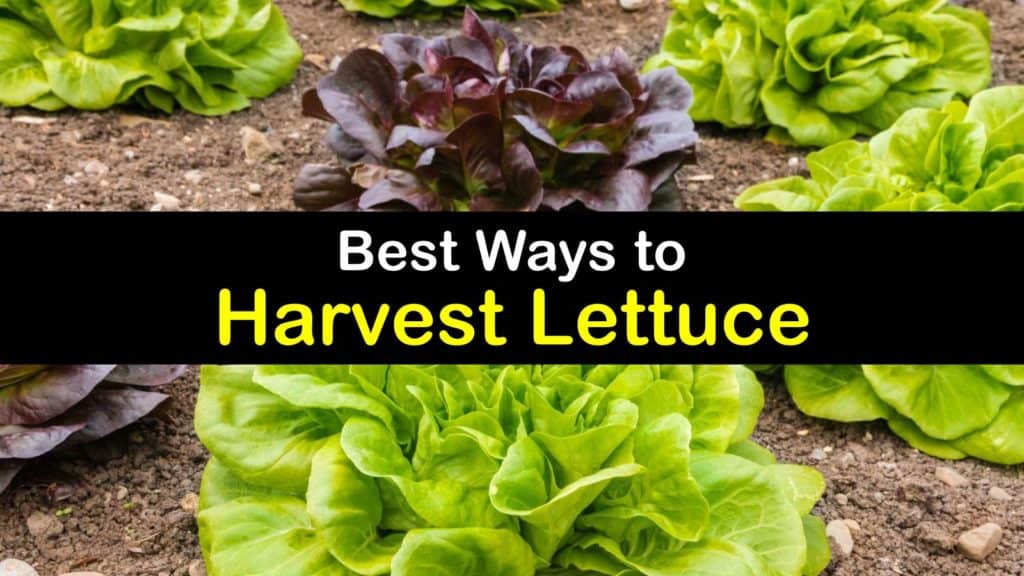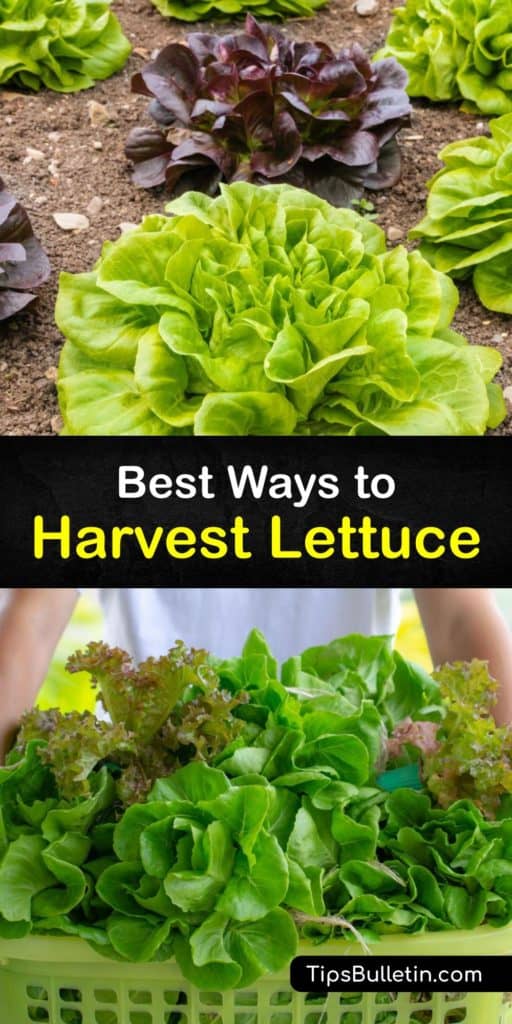It probably doesn’t feel like much of a shock to you that the most widely planted salad vegetables are lettuce plants. Even after you put in all that work during the growing season, knowing how to harvest lettuce in the best way possible isn’t something that just anybody knows how to do.
Without the experience of harvesting lettuce, you don’t realize that there are a few different lettuce growing and harvesting strategies to take.
Figuring out when to pick lettuce is only part of the battle. There are a handful of factors to take into account. We know you’re exploding with pertinent questions.
How long does it take for lettuce to grow? When does your lettuce harvest time end? What tools do you need? Stick around to find out when to harvest lettuce at the perfect time and how to pick lettuce so it keeps growing for a few extra weeks.

How to Grow Lettuce
You’re never going to know how to harvest lettuce if you don’t understand how to sow lettuce seeds, grow lettuce plants and care for them, and snip the leaves before throwing them into your favorite salad bowl.
Lettuce is an annual vegetable that thrives in cool weather. There are dozens of cultivars to choose from, and we go even further into detail about these lettuce varieties later.
Most types of lettuce reach full maturity in as little as 30 days, but some are safe to harvest as microgreens.
Regardless of if you plant them in raised beds, containers, or regular garden beds, giving your lettuce the proper care during its life is the only way to ensure crisp, fresh lettuce leaves for every meal.
Lettuce does not thrive in hot weather, and your best bet at reaching full maturity is to start planting leafy green lettuce types as soon as you can work the soil efficiently.
Most types of lettuce start germination when the soil temperature remains between 40°F and 85°F. With successive planting every ten to 14 days, you’ll have an extended harvest of both loose-leaf lettuce and a head of lettuce.

Head lettuce does best as a fall crop that starts indoors or while protected in a cold frame. However, it is safe to begin planting in the early spring or early fall, regardless of the types you choose to work with.
To know when to pick lettuce, you have to get some plants in the ground first. Find a location for your lettuce heads where they will receive full sun while the weather is cooler and partial shade once the summer heat starts to hit.
Salad greens do best in loose soil with lots of water drainage. Add organic matter to the ground, like compost or manure, and purchase a soil test kit to ensure that the pH level is at least 6.0.
How to Plant Lettuce
Lettuce plants don’t take a lot of work. Sow seeds a quarter to a half-inch deep, cover them with dirt, and water them. Consider alternating each row with a different lettuce type for a whimsical display of texture and color.
Plant about ten seeds per foot of space and keep row spacing 12 to 18 inches apart. The whole head of lettuce has shallow roots, and you want to encourage the leaves to grow as opposed to the roots.
Keep watering lightly but consistently and try to remain moist soil every day. Spreading mulch around the beds helps. If temperatures get too hot, use row covers or shade cloth to give them a break during the hottest portions of the summer.
Tips for Harvesting Lettuce
Once you plant your lettuce, it is time to let them mature and wait to harvest leaf lettuce. There is a perfect time and method to use when learning how to harvest leaf lettuce.
When to Pick Lettuce
Most lettuce types are ready to harvest in 30 to 70 days, depending on your choice. Knowing when to harvest lettuce changes based on the type you grew and what you plan to use it for.
Timing is ultimately dependent on your preference of size. Keep in mind that harvesting in the morning leads to tastier leaves.
How to Harvest Lettuce
There are a couple of possible strategies you can take when learning how to harvest lettuce. The first is harvesting the whole plant.
Removing the whole head of lettuce is something most people do when they want one large yield towards the end of the plant’s growing season. Although effective, this isn’t the best way to continue to produce new leaves for additional weeks.
The best strategy for harvesting lettuce is to remove the outer leaves and consume them while new, center leaves continue to grow. This strategy is easiest with loose heads instead of tight ones.
Whichever you choose to go with, always use sharp shears and snip the outer leaves off at the bottom of their stems. If taking the whole head, cut off the plant from the center seed stalk until the entire upper portion comes off.
Keep lettuce in the fridge for up to a week in the crisper. To preserve lettuce long term, freeze it in a puree to use later for smoothies or soups.
When is It Too Late?
Unfortunately, there is a time where you allow your lettuce heads to grow too long, and they start bolting.
Bolting is when the flower stalk appears from the center of the plant. It is trying to reseed itself. When this happens, the lettuce leaves turn bitter and aren’t something you want to eat.
Growing Different Lettuce Varieties
The four most popular categories of lettuce are romaine, head, loose-leaf, and butterhead. Growing these different types often means different growth strategies in the garden to get the freshest leaves possible. Arugula is a type of lettuce popular with some gardeners, also.
Growing Loose-Leaf Lettuce
Leaf lettuce is some of the easiest to grow. Red lettuce is one of the most popular ones, and lots of people assume it grows differently than green lettuce, but that isn’t true.
Grow leaf lettuce in rows or bundles. They are okay to sow thickly in your garden beds or containers. Harvest the leaves by trimming them a few inches above the soil line and get up to three harvests from it.
Growing Butterhead Lettuce
Boston, Bibb, Oak Leaf, and Buttercrunch are some of the most popular butterhead lettuces. These kinds are known for having tender, green leaves with a white center. They have a slightly buttery flavor and are the mildest of all the lettuces.
Growing Romaine Lettuce
Plant romaine lettuce for a tasty treat. A romaine-lettuce gardener loves the veggie for its crisp center stalks and sweet leaves. Romaine reaches up to 20 inches tall. Harvesting romaine lettuce takes place in about 60 to 80 days from the day you plant it. Some common romaine cultivars are Green Towers, Red Eyes Cos, and Valley Heart.
Growing Iceberg Lettuce
You know about Iceberg lettuce or Crisphead lettuce because it is the crunchiest of them all with lots of water in the leaves. It is one of the most famous salad greens grown all over the United States.
These kinds require a little more care because they love the cold, and you have to avoid a lot of the hot summer weather.
When you do this, the leaves come out even sweeter than you could imagine. Store the harvested leaves in a plastic bag in your refrigerator’s crisper drawer.
Protecting Lettuce
Thankfully, lettuce doesn’t have too many pests that you have to watch for. Aphids are likely to show up, but they are easy to get rid of and deter. Simply pluck aphids to get bugs off lettuce or spray them with the water hose.
Companion planting is an excellent option for keeping aphids away from your lettuce heads. Planting chives as a barrier plant between each row of lettuce keep these pesky insects away.
If they still make their way onto your crops, spray them off with a stream of cool water from your garden hose and inspect the leaves to ensure you rid the plants of them all. Spray some insecticidal soap if you want to take your protection one step further.
Using Lettuce in the Kitchen
There isn’t much more satisfaction in the world than combining all of the veggies you grew in the garden into one scrumptious garden salad.
Throw in whatever veggies you have on hand and toss it with your favorite topping and dressing for a juicy, flavorful lunch.
To make a large salad that serves the entire family, start with a base of four cups of the lettuce leaves of your choice. Eyeball how many tomatoes, cucumbers, carrots, onion, and peppers you want mixed in.
Top all the veggies with a handful of feta cheese and a few croutons. Toss with your favorite dressing to make everything evenly coated and serve it right away.
Finding the timing for when to pick lettuce doesn’t have to be a challenge. In general, lettuces are ready for you to take inside once they reach the size you like.
Lettuce leaves come in different shapes and sizes, but they are something that nearly everyone around the world incorporates into their diet. We can’t get enough of the juicy crunch they provide, and growing them at home makes that texture even better.

If figuring out how to harvest lettuce has filled your crisper drawer with green leaves, share this guide for harvesting lettuce on Facebook and Pinterest.